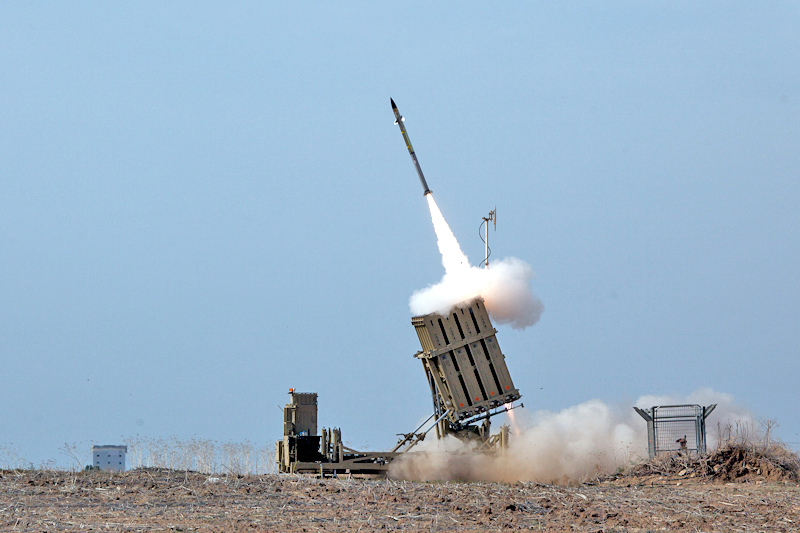The Marine Corps has long been America’s premier expeditionary force-in-readiness, capable of rapidly responding with the necessary tools to crises around the world. In future conflicts, its ability to fulfill this role will be more challenging as peer, near-peer and even “third tier” adversaries develop and field advanced missiles, loitering munitions and attack drone technologies that allow them to threaten Marine combat formations.
Recognizing this threat, the Marine Corps is modernizing its air defense systems, including a recent decision to adopt a mobile variant of Israel’s Iron Dome system. Integrating Iron Dome into its formations will equip Marines with one of the single best defenses against incoming short-range threats available today. The United States should build on this progress and work with Israel on other systems and new technology, to build air defenses that the Marines and US military can operate securely with its other systems.
Since the end of the Cold War, the Marine Corps divested much of its air defense capabilities, including its intermediate range HAWK air defenses in the 1990s, and has instead relied on short-range Stinger missiles, Army Patriot batteries when ashore, and Navy systems while afloat. More recently, the Corps has begun significantly reducing its aviation capacity, which provides a key anti-air function. Now, with the proliferation of increasingly advanced swarming drones, loitering munitions and long-range precision missiles, rebuilding the ability to defeat these systems is essential for mission success.
Neutralizing short- and mid-range aerial threats is critical not just for defending military forces but also to protect civilian populations and critical infrastructure. Iran has repeatedly demonstrated the difficulty of this challenge through proxy attacks targeting American troops and partners throughout the Middle East. During its illegal invasion of Ukraine, Russia has also targeted Ukrainian troops, cities and energy facilities with missiles, and most recently, Iranian-made Shahed drones. China would likely employ similar weapons if conflict breaks out in the Indo-Pacific.
Given that Israel fights in such a contested environment and has built successful air defenses, the United States should leverage its expertise and invest in jointly building systems—like Iron Dome—that the Marines can use. One lesson that should be adopted from Iron Dome, however, is that such joint initiatives should focus not only on the capability of air defense systems but their integration as well.
To address its growing air defense requirement, the Marine Corps’ Medium-Range Intercept Capability (MRIC) program, which was recently approved after passing three live-fire tests, mounts the Iron Dome battery along with its Tamir interceptors on a truck. The system also uses the Corps’ Common Aviation Command-and-Control System, a battle management control system for the Tamir missile, and the new AN/TPS-80 Ground/Air Task Oriented Radar.
But adapting the technology to the Marines’ existing systems was an unnecessary challenge. Although the United States and Israel have collaborated to develop Iron Dome, its adoption by the US military has been hampered because integration is not built into the system. Iron Dome does not naturally operate well with American military platforms.
The US Army, for example, has acquired two Iron Dome batteries, but “cannot integrate them into our air defense system based upon some interoperability challenges, some cyber [security] challenges, and some other challenges,” according to General John “Mike” Murray (ret.) who led the Army Futures Command. The Army deployed the Iron Dome batteries to Guam for testing in October 2021 and conducted a second interception test in New Mexico in mid-June 2022.
Both the United States and Israel are actively working to produce other innovative air defense systems, including directed energy technologies that are much cheaper than kinetic interception and can defeat small swarming drones. One option is Iron Beam, another joint US-Israel project that fires a laser to neutralize threats at closer ranges than Iron Dome. Another option that would provide immense benefits for US troops if it can be integrated well is Israel’s Drone Dome, which is designed to detect, neutralize and intercept through a laser or electronic jammer.
Congress should fund research and development projects that would ease the integration of existing Israeli air defense technologies with US military systems, such as means of securely transmitting data between the systems. Funding innovative air defense technologies, particularly directed energy systems like Iron Beam, is crucial to expanding the capability of US and partner forces to neutralize threats and do so at a lower cost.
Likewise, joint projects should use technologies that are cross-compatible with US military systems. Expanding the number and capability of systems that integrate well with US technologies would not just benefit the United States but also help it develop a regional integrated air and missile defense network that uses these platforms to protect partners throughout the Middle East. Air defenses developed with US funding and cooperation should have the ability to plug into other systems the US military uses. These ventures should include target sharing capabilities that can communicate with US military technologies but minimize cybersecurity risks.
The Marine Corps has taken steps toward adapting Israel’s proven Iron Dome air defense system. This success demonstrates a path toward strengthening protection for American service members with existing and innovative Israeli technologies and developing stronger bonds with a key US partner. America should not pass up this or similar opportunities to better protect its military personnel.
Sam Mundy is a retired Marine Corps lieutenant general who served as commander of the US Marine Corps Forces Central Command from 2018 to 2021. He was a participant in JINSA’s 2022 Generals and Admirals Program. Ari Cicurel is the Assistant Director of Foreign Policy at JINSA.
Originally published in Breaking Defense.

